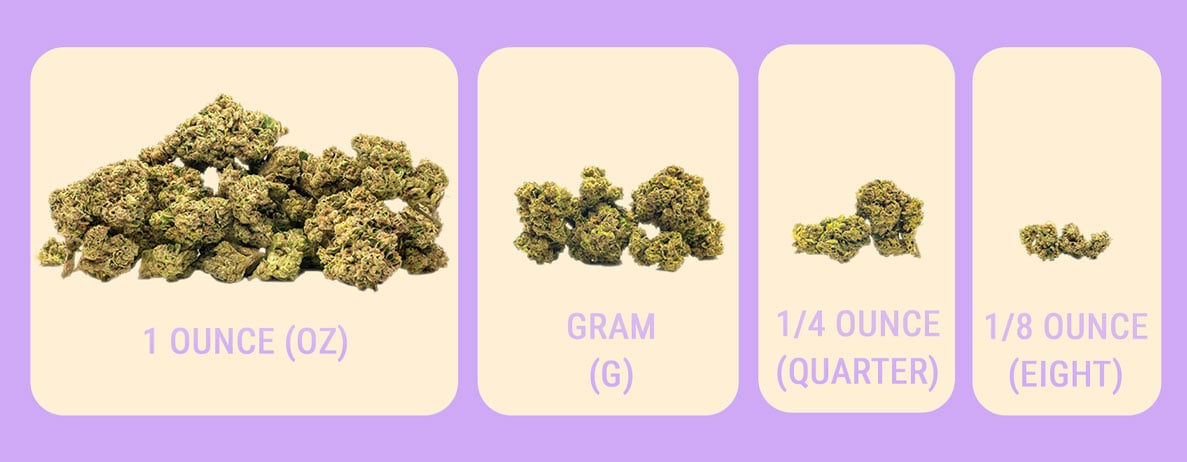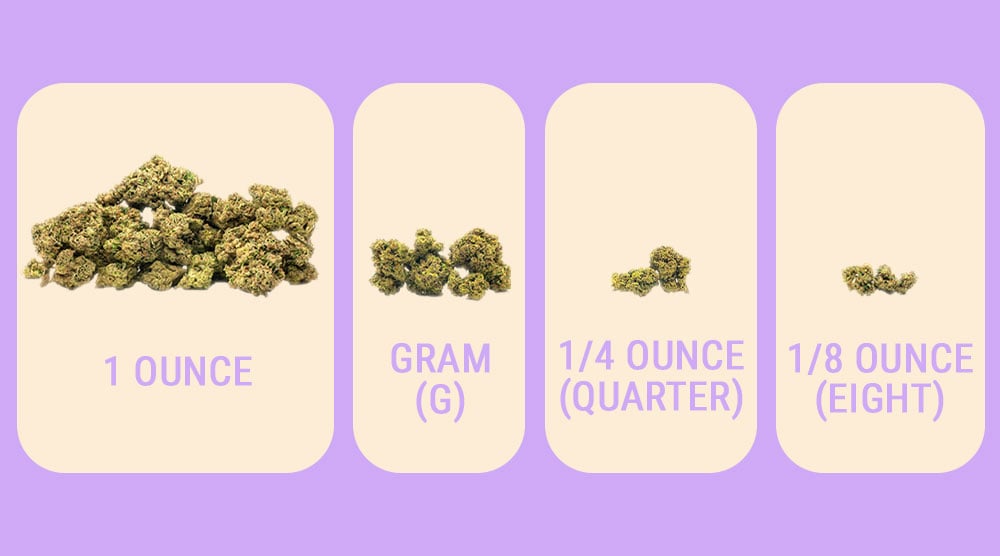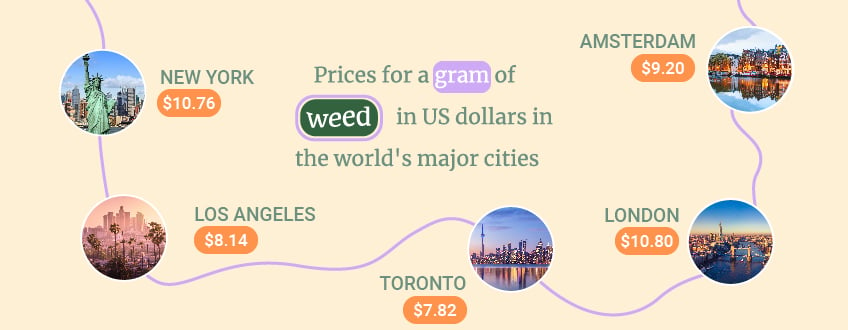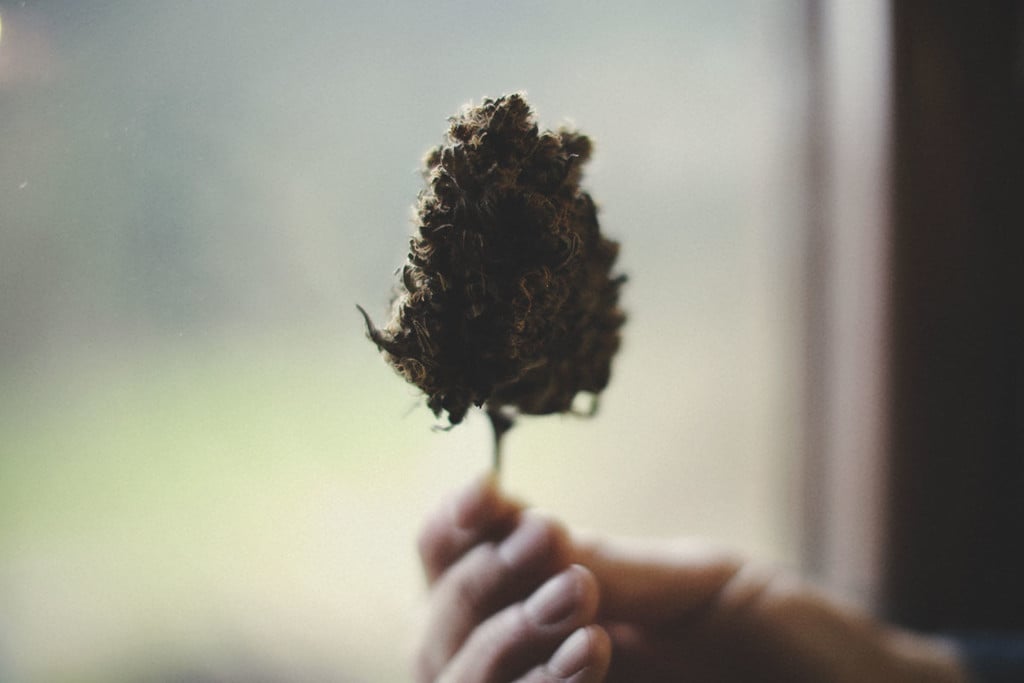.

Gram, Eighth, Quarter, Ounce: Understanding Weed Weights
Do you like to smoke weed, but are unsure of how much to ask for, or unsure of which terms are most appropriate? If you don't know your ounces from your eighths from your grams, don't worry—allow us to break it all down for you.
Contents:
If you're new to cannabis, you probably wish you had paid more attention in maths class. A good knowledge of measurements is helpful when trying to understand the quantities in which weed is sold.
Generally, all cannabis strains are gauged within the context of an ounce. It is possible to buy cannabis in smaller amounts, such as a gram. However, as with many commodities, you get more of a discount for buying in "bulk". For example, buying an "eighth" of an ounce (3.5 grams) will usually cost less than buying three separate grams of weed.
Buying bigger is also possible, but then the matter of the law comes into it. Having any amount of cannabis on you is an offence in some regions. But even in many areas that have undergone partial or complete cannabis reform, the maximum amount you can carry is one ounce.
Any more than that, and you may be suspected of having the intent to supply others. For this reason, it is always best to check the laws where you are or where you are going.


Common Weed Weights
The following are the most common weed weights you will likely encounter when visiting English-speaking countries.
-
Gram
The gram is the base unit used to weigh and sell weed. A gram is one twenty-eighth of an ounce, and will easily fit into the palm of your hand. A gram is the most negligible weight of weed you can buy. Gram is a ubiquitous term of reference used across North America, Europe, and the UK.
-
Eighth (3.5g)
An eighth of an ounce is enough for about 6–7 joints or about 7–10 bowls. Eighth is commonly used in North America, Australia, New Zealand, and the UK. It is less common in Europe, however. For example, in the coffeeshops of Amsterdam, weed is often sold in quantities of 1, 3, and 5g.
-
Quarter (7g)
A quarter of an ounce will be enough for about 12–14 joints or 14–25 bowls. Quarter is a very familiar term used in North America, Australia, New Zealand, and the UK.
-
Half (14g)
Half of an ounce will fill roughly 30 joints and around 40 to 50 bowls. The term is used in most Western countries, such as the US, Canada, Australia, New Zealand, and the UK.
-
Ounce (28g)
A full ounce of cannabis will roll around 60 joints or pack over 100 bowls. Ounces are a standard measurement in regions where people still use imperial units. Although, ounces are occasionally used for measuring cannabis in countries where the metric system prevails.
-
Pound (453g)
The pound is an imperial measurement used commonly in the US. A pound comprises 16 ounces of weed—16 times the most considerable amount that (in many places) anyone can legally have on their person at any one time. You may wonder, if there are 16 ounces in one pound and 28 grams in one ounce, wouldn't there be 448 grams in a pound? This discrepancy is because the gram is a metric unit.
Ver esta publicación en Instagram
How Much Weed Is in a Joint?
It varies from person to person, depending on how you roll. But one gram is usually enough for 1–2 joints or 1 small blunt. Pre-rolled joints are typically sold in half-gram or full-gram varieties.
The Importance of Bud Density in Weed Weight
An important factor to be aware of when it comes to weed weight is the density of cannabis flower. This can vary significantly among strains, making your chosen quantity look like more or less than you were expecting. A quarter of Gelato, for example, will look smaller than a quarter of Maui Wowie, which will appear light and fluffy.
Slang Terms for Weed Weights
Below are some additional terms used to describe different weights or amounts of weed in various areas of the English-speaking world.
- Nick: A nick equates to 5 dollars of weed—about half a gram. Enough for a spliff when you are desperate. Used in the US.
- Dime / dime bag: This is a 10-dollar bag of weed. The quantity is not precise, but it is generally somewhere between half a gram to a gram. A dime will go further if you use it in a pipe as opposed to a roll-up. Used in the US.
- Dub: A dub is 20 dollars worth of weed, equating to roughly 1.5–2 grams. Some savvy dealers might offer you a discount, such as a "15-dollar dub". Used in the US.
- Key: Refers to a kilo—approximately 2.2 pounds. The price of a key is not set, and not all dealers will trade in such large amounts. A key is typically bought for reselling rather than for personal use. Used in Europe and the UK.
- Slice: A slice is another name for an eighth. Used in the US and Canada.
- Zip: Another term for an ounce of weed. The origin allegedly relates to an ounce of weed fitting comfortably in a Ziploc bag. However, other theories imply that "zip" comes from the abbreviation for ounce, oz. Primarily used in the US.
- Sawbuck: 10 dollars worth of weed. Used in the US.
- "A 20": 20 dollars worth of weed. Used in the US, Australia, and New Zealand.
- "A 50": 50 dollars worth of weed. Used in the US, Australia, and New Zealand.
- Stick: A stick is comparable to a single gram of cannabis. Used in Australia and New Zealand.
How to Weigh Weed Without a Scale
Although digital scales are incredibly accurate, you may not always have one on you—especially if you are travelling. So if you are buying some weed, how can you double-check the weight to know if you are getting ripped off or not? One way is by using the penny and ruler method.
For reference, a UK 1p coin weighs 3.56g, a US cent weighs 2.5g, and a Euro cent weighs 2.3. By knowing these figures, you can create a small weighing scale using your ruler. With the penny on one side, and the weed on the other, you can balance the amount and determine how much weed you have.


How Much Does a Gram of Weed Cost?
Weed prices are constantly fluctuating, and are based on many variables. More potent or rare strains will cost more because their demand is higher, and the supply is shorter. Even how and where a strain is grown can impact price. Of course, another significant factor is who you are buying it from. Is it a friend? A long-time dealer who rewards you for your loyalty? A stranger in a new city? Or a budtender at a legal dispensary?
Whether you are in a region where cannabis is legal or illegal will make a big difference. In areas with legal cannabis dispensaries, some black market dealers will push budget-priced cannabis that undercuts legal prices.
Contrarily, some connoisseur black marketeers sell at prices higher than legal dispensaries. The justification for this is that top-grade "black market weed" is better. It may be that it is grown organically or that the genetics are better—or it could just be to make an extra buck.
Prices also vary significantly based on the risk attached to getting caught.
Suppose we are going on ballpark averages, however; we can use the latest data available from the 2018 Cannabis Price Index to tell us. This study condensed data collected by the United Nations Office on Drugs and Crime (UNODC). It lists the approximate prices for a gram of weed in US dollars in the world's major cities:


New York — $10.76
Los Angeles — $8.14
Toronto — $7.82
London — $9.20
Amsterdam — $10.80
Of course, you can avoid the hassle of measuring, weighing, and pricing up weed by just growing your own. This way, you get the ultimate value for money, producing the perfect strain for you and having a tailored supply ready whenever you want it. It's a no-brainer!





































